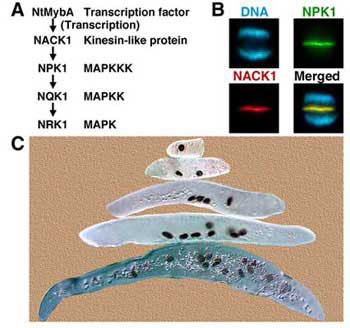| I. THE MAP KINASE
PATHWAY
THAT CONTROLS PLANT CYTOKINESIS Recent references Nishihama et al., Genes & Dev. (2001) Ito et al., Plant Cell (2001) Nishihama et al., Cell (2002) The tobacco mitogen-activated protein kinase kinase kinase NPK1 regulates lateral expansion of the cell plate at cytokinesis. We have recently showed that the kinesin-like proteins (KLPs) NACK1 and NACK2 act as activators of NPK1. Biochemical analysis suggests that direct binding of NACK1 to NPK1 stimulate kinase activity. NACK1 is expressed specifically in M phase and co-localized with NPK1 at the phragmoplast equator. Overexpression of a truncated NACK1 protein that lacks the motor domain disrupts NPK1 concentration at the phragmoplast equator and cell plate formation. Incomplete cytokinesis is also observed when expression of NACK1 and NACK2 is repressed by a virus-induced gene-silencing and in embryonic cells from Arabidopsis mutants in which a NACK1 ortholog is disrupted. Thus, we conclude that expansion of the cell plate requires NACK1/2 to regulate the activity and localization of NPK1. Movie
1: Moving of location of GFP-NPK1 during expansion of phragmoplast (~3.5MB)
|
